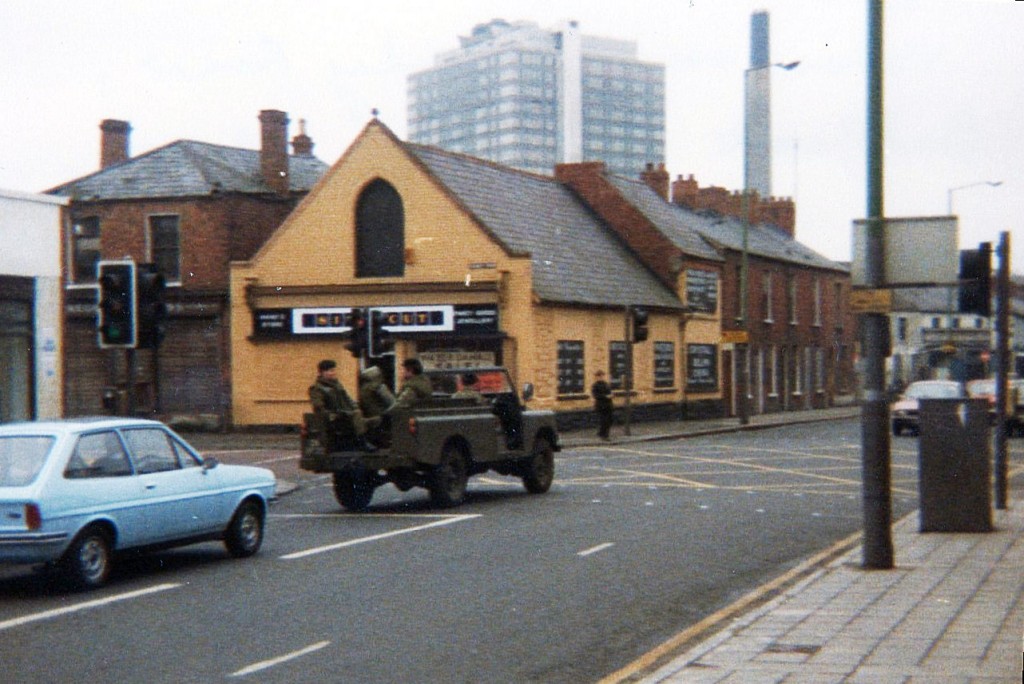Attempts to draw comparisons between the Troubles and the Arab-Israeli conflict only serve to excuse terrorism and obscure the real issues.
In recent years, debates over how the Israeli-Palestinian conflict might be resolved have begun to make frequent reference to a fairy tale. This tale is based on the supposedly similar conflict in Northern Ireland between Great Britain and the Provisional IRA. That conflict was ultimately resolved with a peace treaty, and the suggestion is frequently made that if only Israel and Hamas could be persuaded to implement its lessons, then all would quickly be made well.
The fairy tale goes something like this:
“Once upon a time, there was a bloody, decades-old sectarian conflict with roots going back centuries. Eventually, the British realized that violence was never going to defeat their bitter enemy, the Provisional IRA. They got over their foolish reluctance to negotiate with terrorists and entered into meaningful talks. In the end, painful concessions were made by both sides and nobody got exactly what they wanted. Nevertheless, a historic agreement was achieved that finally brought an end to the violence.
Now if that was possible in Northern Ireland, surely it must be possible in the case of the Israeli-Palestinian conflict too. If only the government of Israel would follow the noble example of its British counterpart and enter into meaningful negotiations with Hamas, then surely a fair solution to the conflict would soon be produced.”
So just substitute the Israeli government for the British one, Hamas for the Provisional IRA, and, perhaps, Israelis living beyond the Green Line for Northern Ireland’s Protestant majority, and it’s clear what everyone has to do. In return for a ceasefire called by Hamas, Israel must enter into meaningful negotiations with the group and make substantial concessions (otherwise the talks wouldn’t be “meaningful”). Hamas would then be required to offer some assurances about refraining from the mass murder of civilians. Thus a resolution of the conflict would be achieved, not satisfactory to either side but sufficient for a long-term end to violence, permitting ordinary people on both sides to get on with their lives unhindered by the threat of terrorism and intermittent warfare.
This is an attractive story, and it’s not surprising that both the losers (the Provisional IRA) and winners (the British government) of the conflict in Northern Ireland like to repeat it. Nor is it surprising that people innocent of any knowledge of Ireland or its history—including some Israeli leftists—are fond of doing so as well. It’s also popular with far less reputable pro-Palestinian groups, whose desire to put an end to the Jewish state often comes swaddled in the soothing language of peace, equality, and human rights.
More worrying is the recent appearance of an article and book on the subject by Jonathan Powell, who served as former British Prime Minister Tony Blair’s Chief of Staff during his entire ten years in office. Powell lends significant prestige to the fairy tale due to his role as a key actor in the Northern Ireland peace negotiations. But Powell is more than that. He is the son of an Air Vice-Marshal and brother of Lord Powell of Bayswater—a key foreign policy adviser to Prime Minister Margaret Thatcher and her successor John Major. Thus, Powell’s endorsement of the fairy tale indicates that its popularity is growing among government and policy elites who can have a real effect on the Middle East peace process itself.
None of this would matter, of course, if the fairy tale were true. But like all fairy tales, it isn’t. In fact, drawing an analogy between the conflict in Northern Ireland and the Middle East is not simply unjustified; it is an error of the grossest kind. And it directly threatens Israel’s well-being by justifying demands for Israeli concessions to an enemy that is very different—and, yes, far worse—than the enemy Britain faced in Northern Ireland.
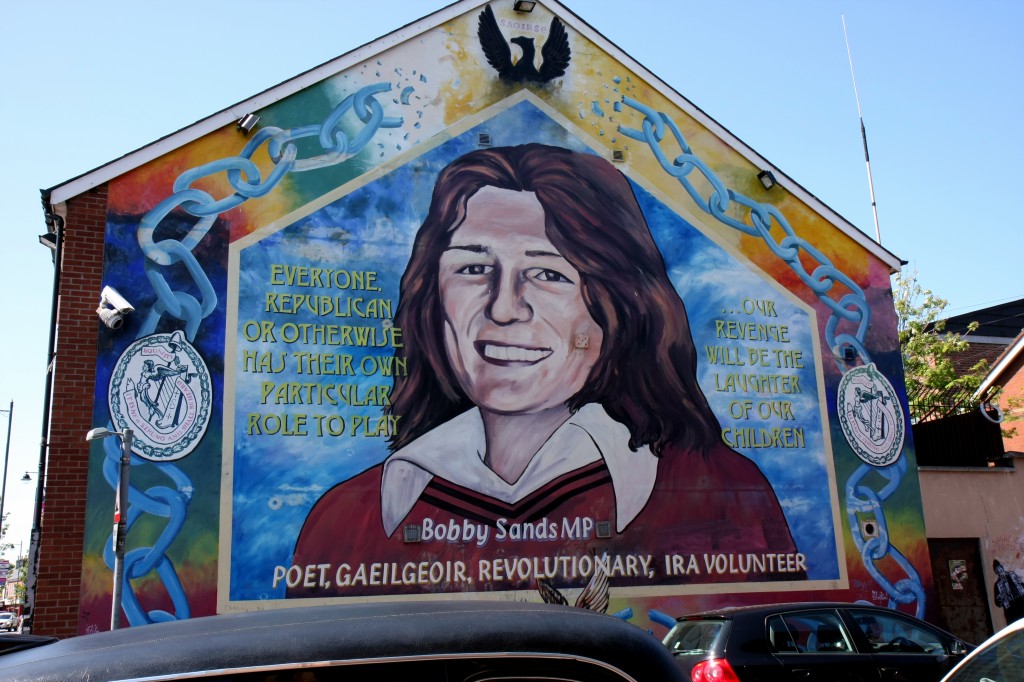
A mural commemorates Bobby Sands, a Provisional IRA member who died in prison while on hunger strike. Photo: Carrie Sands / Wikimedia
Words have real effects on the world, and Israel is fighting false and pernicious ideas as well as terrorist groups, not to mention a rise in European anti-Semitism and demonization of Israel that is taking on the characteristics of a social movement, involving elements of both Left and Right. In such circumstances, it is worth examining one of those false and pernicious ideas in depth, and trying to understand what the Northern Ireland conflict was really about, how it was brought to an end, and whether there is in fact anything that Israel can learn from the experience.
The fairy tale holds that the terrorist group the British fought in Northern Ireland, the Provisional Irish Republican Army, is analogous to the Palestinian terrorist group Hamas. Accordingly, Israel should act toward Hamas as the British did to their terrorist enemy. To examine this claim, it is necessary to know where the Provisional IRA came from, what its aims were, and to what extent they were achieved.
In 1922, Ireland was partitioned into an independent Irish Republic and the six counties of Northern Ireland, which remained part of the United Kingdom. Many people in Ireland have always seen this as a grave historical injustice. Northern Ireland enjoyed its own autonomous parliament and administration, and was a political entity custom-made for its Protestant majority (referred to as “Loyalists”). The Protestants didn’t hesitate to use this status in order to systematically discriminate against the Catholic minority (the “Nationalists”), which they saw as disloyal to the state and adherents of primitive religious beliefs. For over four decades, there were occasional outbreaks of IRA violence against the regime, but they were ineffective and failed to gain support from the Nationalist minority.
Things changed dramatically toward the end of 1960s. A new generation of Nationalists had grown up with the benefits of the post-war British welfare state, and was ever more unwilling to accept their status as second-class citizens. The ferment on university campuses around the world, particularly the Civil Rights movement and the protests against the Vietnam War in the United States, also had an effect. Protests by the Nationalist minority broke out, initially focused on the issue of unfair allocation of public housing. They were met with savage repression by the overwhelmingly Protestant security forces.
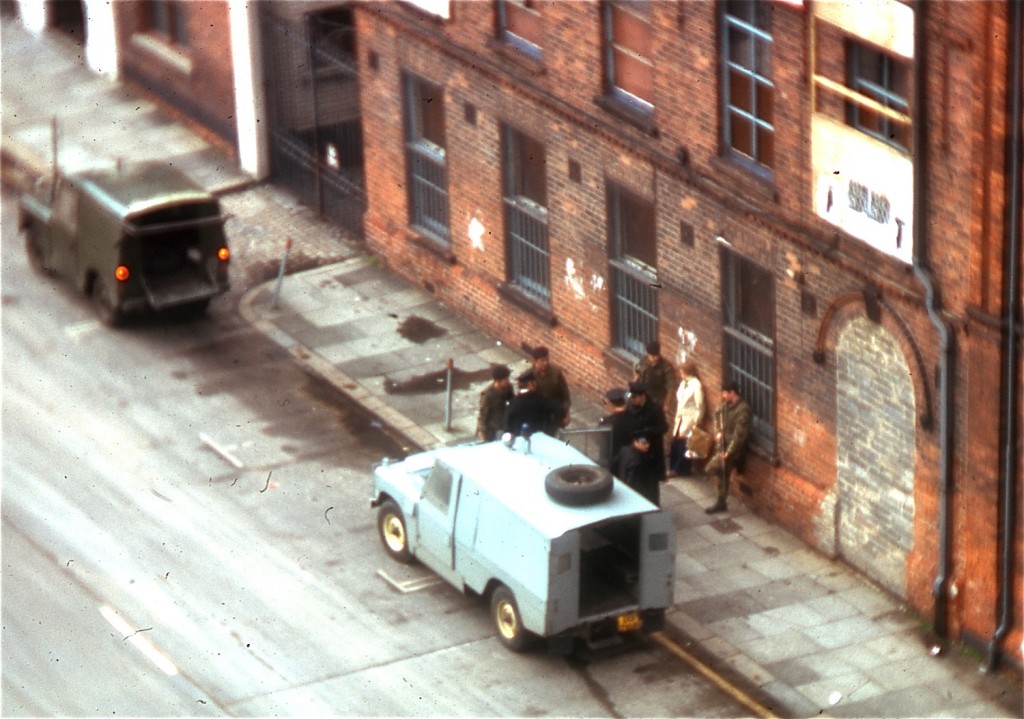
1974: British troops interrogate a couple outside Belfast’s Europa Hotel, which was known as the “most bombed hotel in the world” after suffering 28 bomb attacks during the Troubles. Photo: George Louis / Wikimedia
This resuscitated the previously moribund IRA. Some saw it as the only force willing to defend Nationalist communities from rampaging Loyalist mobs, aided and abetted by the forces of the state. For reasons that need not concern us here, the IRA faction that went to war most enthusiastically and effectively against the British state in Northern Ireland became known as the Provisional IRA—“the Provos.” The Provos regarded their ruling body, the Army Council, as the sole legitimate government of both Northern Ireland and the Irish Republic, and the aim of their campaign can be reduced to just two words: “Brits Out!”
It’s important not to forget the simplicity of this aim. Though the struggle for civil rights in Northern Ireland provided the breeding ground for the birth of the Provos, they fought for one thing only: To force the British state to abandon Northern Ireland.
So what did the Provos ultimately achieve? The Good Friday Agreement of 1998, on which the present settlement in Northern Ireland is based, states that
While a substantial section of the people in Northern Ireland share the legitimate wish of a majority of the people of the island of Ireland for a united Ireland, the present wish of a majority of the people of Northern Ireland, freely exercised and legitimate, is to maintain the Union and, accordingly, that Northern Ireland’s status as part of the United Kingdom reflects and relies upon that wish; and that it would be wrong to make any change in the status of Northern Ireland save with the consent of a majority of its people.
Clearly, the Good Friday Agreement is nothing like the Middle East’s “two-state solution.” Northern Ireland remained firmly a part of the United Kingdom, and the Provos in effect acknowledged that this was right and proper. Indeed, their political wing—the Sinn Féin party—renounced violence and joined the Northern Irish government. It is no exaggeration to say that after a decades-long campaign of murder and destruction directed toward expelling the British from Northern Ireland, the Provos have now transformed themselves into the guardians of British rule. In fact, the agreement also led to the Irish Republic itself abandoning its constitutional claim to the six counties of Northern Ireland.
Other articles in the agreement do agree to change the constitutional status of Northern Ireland should the majority of its people wish to do so. But the chances of this happening are roughly similar to that of a majority of Israelis voting to form a bi-national state with the Palestinians. Loyalists are still a very comfortable majority in Northern Ireland and, if a referendum were held on the subject, it is doubtful whether even the entire Catholic minority would vote to abandon British rule.
Thus, the Good Friday Agreement gave the Provos precisely the opposite of what they wanted. It led both the Irish Republic and the Northern Irish Nationalists to legitimize the partition of Ireland, something both had passionately refused to do for the better part of a century. In exchange, the Nationalists received guarantees on human rights and a reformed autonomous parliament, a deal that had been on offer for at least two decades. The only concrete concession the British granted was to parole Provisional IRA members who were serving sentences for terrorism and other crimes.
As former IRA member Gerard Hodgins recently put it,
We lost. It’s a crazy situation where you set out to be revolutionaries to overthrow the state and ended up being caretakers of the state. … 3,000-plus dead is a hell of a price to pay to become part of the state you were supposedly trying to overthrow. You could have become a part of that state a long, long time ago.
What possessed the Provos to, in effect, abandon their previous beliefs and surrender to the British? A complex range of factors were involved, but these are the most important:
1. Exhaustion with the war. By the beginning of the 1990s, the arrogant young gunslingers of the early 1970s had lost their appetite for the privations of armed struggle. Many were either dead or imprisoned, and others had the will to fight beaten out of them by their interrogators at the notorious Castlereagh detention center.
2. The growing effectiveness of Britain’s intelligence agencies severely reduced the combat effectiveness of the Provos, and may have helped the British government nudge it toward electoral politics and the renunciation of violence.
3. The Provisional movement realized that, while armed struggle was a dead end, a lot of people in Northern Ireland would be willing to vote for a Nationalist political party that was no longer just the legal mouthpiece for the Provos. This led to the current participation of Sinn Féin in the Northern Irish government.
In order to grasp just how far this is from the Middle East conflict, readers should imagine a future in which terrorist masterminds Mohammed Deif (if he is still alive) and Khaled Mashaal are prominent political leaders of a Judea and Samaria Autonomous Region of Israel. They stand politely when “Hatikvah” is played, condemn political violence in all its forms, speak the language of human rights and equality, and claim that their new role is simply a continuation of the struggle for Palestinian national rights by other means. Even more amazingly, the bulk of their followers believe and vote for them. Just how ridiculous this scenario sounds illustrates the chasm separating Hamas from the Provisional IRA in terms of political culture, methods, and aims.
The Provisional IRA was like Hamas in that it was indeed a terrorist organization that deliberately set about killing civilians and attacking soldiers and other security forces. There, however, the similarities end.
Unlike Islamic radicalism, Irish nationalism has always been somewhat ideologically underdeveloped. Nonetheless, a few things can be said with certainty about the worldview of the Provisional IRA. Most importantly, perhaps, the Provos did not see the conflict as a zero-sum game. They did not advocate the genocide or ethnic cleansing of the Protestant majority, did not claim that London was the true capital of Ireland, and were not motivated by an ideology of racial or religious supremacism. Their slogan “Brits Out!” referred to the British state alone, not the Protestant community loyal to it.
On a larger scale, the Provisional IRA did not see itself as just one part of a grand holy war against the presence of a Protestant community in Northern Ireland. Unlike Hamas, the Provos never had the benefit of an Iran or a Qatar to provide it with consistent material and moral support. They did not enjoy the solidarity of a global movement of fundamentalist Catholics willing to use terrorism and mass murder to achieve their religious aims. Nor did they have a growing chorus of sympathizers in the Western liberal democracies. At best, they had to rely on the occasional gift of arms from the crazed Libyan tyrant Muammar Qaddafi and what money deluded immigrants in the bars of Boston and New York could be persuaded to part with.
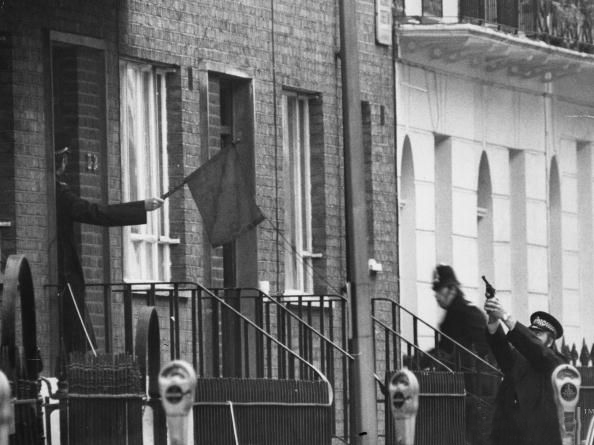
London police react to the Balcombe Street Siege, when IRA members took a couple hostage in their apartment. Photo: Rob Baker
Perhaps as a result of their limited ambitions, the Provos’ ideology was not based on the denial of the Protestant community’s right to exist. Instead, it held that Loyalists were suffering from a kind of false consciousness imposed on them by the British government. Once the Brits were out, the Protestants would come to their senses and realize that their best interests lay in accepting their role as full citizens in a new, all-Irish state. Indeed, up until the mid-1980s, it was official Sinn Féin policy—expressed in the party’s Éire Nua (New Ireland) policy paper—that the re-founded Irish Republic would include an autonomous parliament for its northernmost nine counties.
Of course, this view of the Loyalists was based on fantasy and might be described as, at best, patronizing; but it is very different from Hamas’ attitude toward the Jews. The Loyalist people of Northern Ireland are overwhelmingly descended from Scottish colonists sent by Britain in the 17th century. Known as the Plantation of Ulster, the specific purpose of this project was to make Ireland British. The colonists—all of them Protestants—were settled on land seized from the Catholic population. Yet the Provos never called for the uprooting of Protestant “settlements” in Northern Ireland, and never called for Catholics to be given back the land the “settlers” took from them. Their ideology did not seek to wind the clock back to some sort of pre-Plantation Shangri-La when Ireland was free from foreigners who professed the wrong religion, and there was no suggestion that the Loyalists belonged anywhere other than where they were.
Putting aside the obvious differences between the Protestant presence in Ireland and the Jewish presence in the Land of Israel—which has been constant in some form for over 3,000 years—it will not be difficult for readers to see how different this is from Hamas’ view not only of Jewish settlers but the State of Israel itself.
The Provisional IRA was like Hamas in that it was indeed a terrorist organization that deliberately set about killing civilians and attacking soldiers. There, however, the similarities end.
Not only did the ideology of the Provisional IRA lack any call for ethnic cleansing, it was also not fundamentally motivated by religion, in spite of the fact that the movement was made up entirely of Catholics. If modern Irish nationalism had a founding father, it was Theobald Wolfe Tone, a Protestant. And like Tone, many of the other leaders of the Society of United Irishmen—which, influenced by the American and French revolutions, led the failed 1798 rebellion against British rule—were Protestants as well.
The Islamic radicalism that motivates Hamas, in contrast, is completely incapable of including non-Muslims. While the Provisionals sought inspiration from Wolfe Tone and others who tried to build an Irish national identity that would transcend religious divisions, the ideology of Hamas is based on racial hatred and the supremacy of one religion over all others. Those with doubts on this point would be well advised to read the organization’s founding Covenant. Hamas is a lot of things, but they are not hypocrites.
Finally, the Provisional IRA never embraced a cult of death or a self-sustaining and self-justifying culture of “resistance.” While many Provos ended up dying for their cause, their objective was always to make others die for theirs. It is as impossible to imagine a member of the IRA committing a suicide bombing as it is to imagine an IRA leader ordering him to do so. The seven members of the Provisional IRA who died on hunger strike in prison in 1981 do not constitute an exception to this; they were engaged in a battle of wills with the British government over the conditions of their confinement and would have happily stopped starving themselves at any time had the British administration ceded to their demands.
The fairy tale version of the conflict in Northern Ireland posits that it was only ended by the British government’s willingness to negotiate with terrorists, who could not be defeated by force. Accordingly, the tellers of the tale claim that Hamas also cannot be defeated by force, and Israel must negotiate with them however distasteful the prospect might be.
But this version of the conflict in Northern Ireland is based on a self-serving fantasy. The Provisional IRA does not want to admit that it lost, and the British do not want to talk, possibly not even to think, about the means they employed in order to win. Nonetheless, the truth is that the conflict ended not because the Provisional IRA couldn’t be defeated, but because it was defeated.
The fairy tale elides this issue by focusing on the period that started with the various maneuvers leading to the first IRA ceasefire in 1994 and ended with the signing of the Good Friday Agreement in 1998. The use of this very specific time period is quite understandable when the means used by the British to fight the Provos are considered. Indeed, the British mandarin class to which men like Jonathan Powell belong has never been keen to talk about the amount of blood it has on its hands from various colonial and post-colonial conflicts.
The British don’t want to talk about what they did in Northern Ireland, but what they did worked. The Provos did not come to the negotiating table from a position of strength. They only became seriously interested in negotiations when their capacity for violence had been severely reduced by a 20-year counterterrorism campaign. It was not a pretty war. The British employed tactics like mass internment without trial, juryless courts, and interrogation techniques amounting to torture; as well as the assassination of Nationalist activists and lawyers such as Pat Finucane and Rosemary Nelson. Indeed, at the time this article is being written, the British government’s refusal to come clean about the techniques it used to beat the Provos—in many cases, literally—continues to pose a threat to the viability of Northern Ireland’s autonomous government.
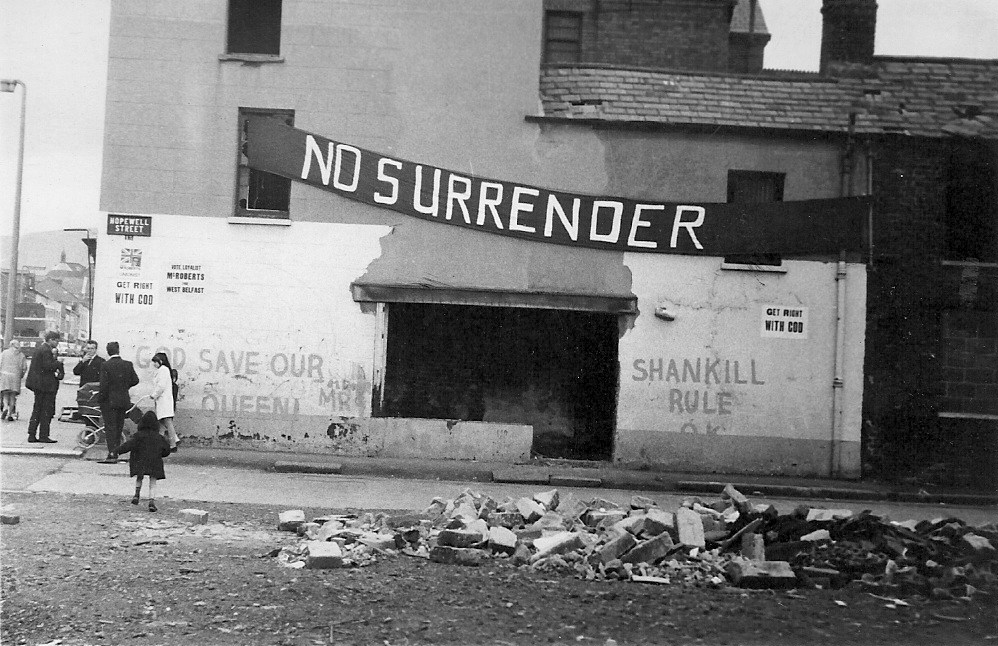
Banner and graffiti on a building in a side street off the Shankill Road, Belfast, 1970. Photo: Fribbler / Wikimedia
Another key element in the British war against the Provos was the “Ulsterization” policy introduced in the mid-1970s. This gave a front line role to the RUC (the Northern Irish police) and the UDR (a British Army regiment recruited in Northern Ireland). British army units from outside the province were only deployed in areas where it was too dangerous for local forces to set foot unescorted. The introduction of this policy had the effect of gradually making it more and more difficult for the Provisional IRA to kill members of the British security forces. Deaths among local forces had much less resonance with British public opinion than casualties inflicted on military units from elsewhere in the UK. The Provos were thus reduced to what in many cases amounted to no more than a murder campaign against their Protestant neighbors.
There is also good reason to believe that the British intelligence services penetrated the Provos with ever greater success as the years went by. Not only did this give the British the opportunity to frustrate attacks by the Provos (as well as permit some in order to maintain the credibility of their sources, another grave moral compromise on Britain’s part), it also gave them insight into the thinking of Nationalist leaders. Indeed, it is possible that the British may have played a role in keeping these leaders in power once it became clear that they were looking to shift from violence to politics.
Less objectionable measures were also used to defeat the Provos. Starting in the mid-1970s, serious efforts were made to dismantle the formal and informal system of discrimination in Northern Ireland, gradually tamping down the rage and resentment felt by Catholics over decades of sectarian prejudice.
This very brief summary of how the British fought the Provos should make it clear that, contrary to the fairy tale, fighting and negotiating are not polar opposites. Instead, they are part of a continuum of options available to participants in an armed conflict who seek to impose their will on each other.
This is related to perhaps the most important claim made by the fairy tale: That, in the early 1990s, the British underwent a change of heart and finally decided, after years of refusal, to negotiate with the Provos. It’s a good story, but it’s quite simply false. Both backchannel and other, more open communications between the Provos and the British government took place throughout virtually the entire conflict. The 1972 IRA ceasefire, for example, led to a delegation being flown to London for talks with the British government. The talks failed because the IRA insisted on setting a date for British withdrawal. When the British refused, the talks collapsed, because the IRA remained confident that the British could be forced to leave Northern Ireland due to their inability to stomach the cost of maintaining the union.
The British turned out have a bigger stomach for the fight than the IRA’s leaders imagined. A generation later, they had a wearier and more realistic view of things. In the end, they gave in, receiving terms that were not appreciably better than those they would likely have gotten in 1972. The British did not have a change of heart, the IRA did.
Given the vast differences between the Provisional IRA and Hamas, and between the nature of the conflict over Northern Ireland and that of the Middle East, as well as the patently false narrative of British capitulation to IRA terrorism, one might wonder whether Israel can learn any direct lessons from the conflict.
Possibly not. Certainly, the fairy tale version has nothing to teach us. But it is worth making some general observations about the true nature of the conflict in Northern Ireland and how it ended. It is possible that the true story, rather than the fairy tale, may be of some relevance.
1. The conflict in Northern Ireland had its roots in the 1640s. The modern struggle to build a state for the Jewish people only began in the 1880s. We may hope that resistance to Jewish sovereignty in their ancient homeland will weaken significantly in our lifetimes, but it may well continue, perhaps for centuries.
2. Final victory, when and if it comes, might be difficult for some to recognize. It may involve attempts to spare the dignity of the enemy that will enrage or perplex people on the other side. In Northern Ireland, there are still many Loyalists who cannot stomach the sight of Nationalist leader Martin McGuinness shaking hands with Queen Elizabeth II and talking about how much he admires her. They think he should be either dead or imprisoned. But his embrace of the British establishment is the clearest sign of their victory.
3. Carefully measured military action is an unavoidable part of a struggle against terrorism. But so is resisting the temptation to allow the armed forces to “solve” the problem once and for all in a blaze of righteous violence. Margaret Thatcher doesn’t get enough credit for refusing to let security forces off the leash in the wake of the Warrenpoint Ambush in 1979 and the nearly successful attempt on her own life in 1984, two of the high points of the IRA’s terrorist campaign. The Provos may have gotten emotional satisfaction from these attacks, but they made no overall difference to the final outcome of the conflict.
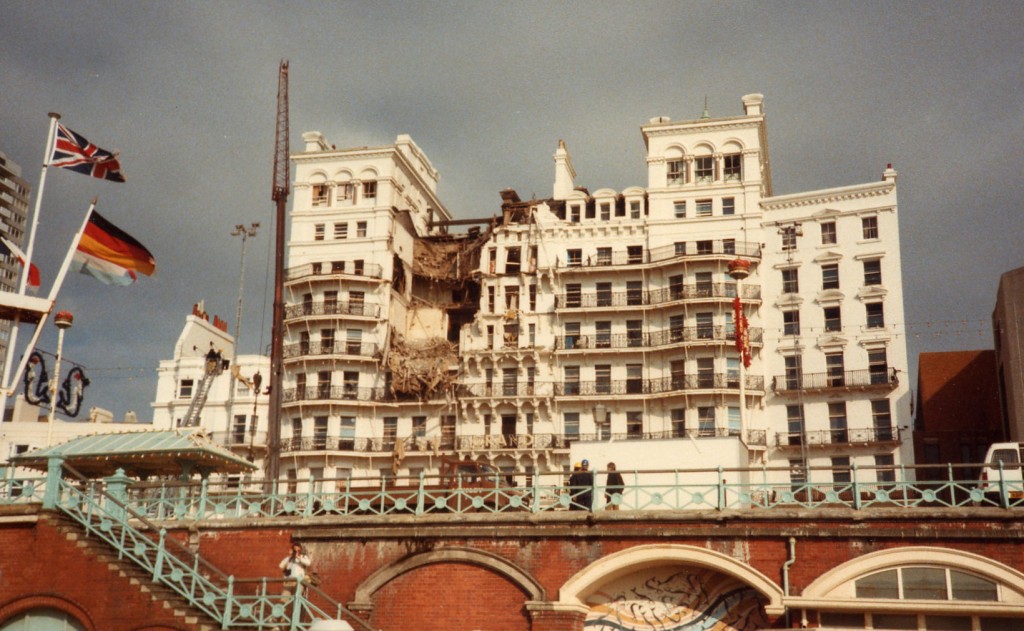
The Grand Hotel in Brighton, England, was bombed in an attempted assassination attempt on Prime Minister Margaret Thatcher in 1984. She was unharmed, but five people were killed. Photo: Magnus Manske / Wikimedia
4. Sectarian discrimination in Northern Ireland provided the conditions for the birth of the Provisional IRA, but they were not the root cause of the conflict. That said, high public spending in Northern Ireland and the gradual elimination of anti-Catholic discrimination helped wear down support for violence in the Nationalist community. It is possible to recruit people with jobs, houses, and a future into a campaign of nationalist violence, but there is reason to believe that it is much more difficult.
5. Channels of negotiation were almost always kept open between the British and the Provos. There were even some failed attempts at serious negotiations. But talks on matters of substance only made real progress when the Provos started to lose their stomach for the fight.
6. The British government tolerated and at various times connived with extreme Loyalist groups. Its security forces sometimes collaborated with them to murder Nationalists. However, it also jailed members of these groups by the hundreds. Who was using who in their relationship was never in doubt.
7. At times, the British were sorely tempted to launch retaliatory or hot pursuit raids into the Republic of Ireland. But apart from two grave exceptions, they restrained themselves, and preferred imperfect but ever-improving cooperation with the Irish government.
8. The huge number of people of Irish birth and descent living in other parts of the United Kingdom were largely (though not exclusively) left unmolested by the British authorities throughout the conflict.
9. Even now, the conflict isn’t completely over. The autonomous government of Northern Ireland is again teetering on the brink of collapse and dissident Nationalist groups continue to be active, though their strength and political relevance is far from that of the Provisional IRA at its height.
One thing is certain, however: The fairy tale version of the conflict in Northern Ireland offers no useful guidance to any party in the Israeli-Palestinian conflict. Quite the opposite, in fact.
To the Israelis, it offers only the illusion that spontaneous concessions to their enemies will bring them something better than their enemies’ contempt followed by further demands.
In regard to the Palestinians, it misrepresents the nature of Hamas’ ideology and whitewashes the organization’s dedication to violence and even genocide. In effect, it reduces the Palestinians to colorful Orientals incapable of meaning what they actually say.
Most importantly, however, the fairy tale actually makes peace less likely by recommending capitulation to terrorism rather than a determined and patient fight against it. In fact, that determined fight was the only thing that ultimately brought the IRA to the negotiating table.
There can be no doubt that the last thing the people of the Middle East need is anything that makes peace less likely. For their sake, let us hear no more of the Northern Ireland fairy tale.
![]()
Banner Photo: Jorge Royan / Wikimedia






